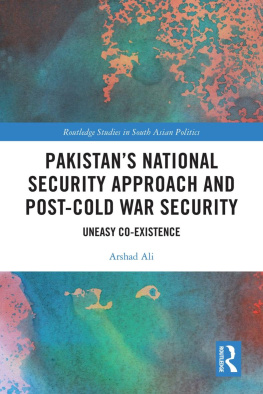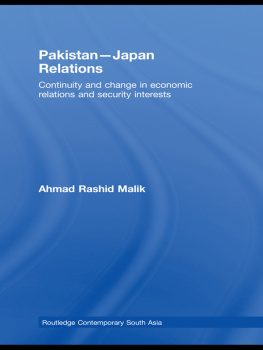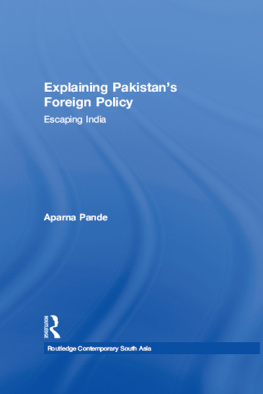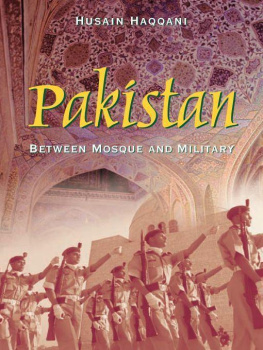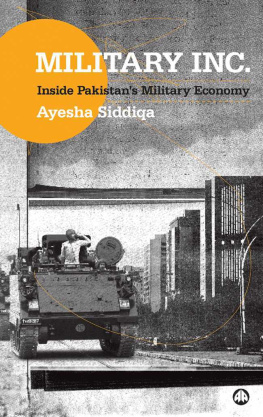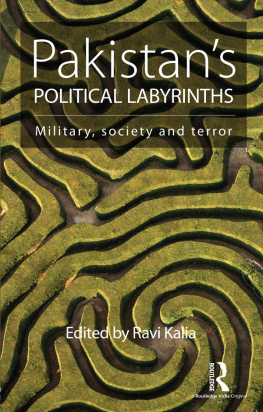Omar Noman's university education, in economics and politics, was spread over Karachi University, St John's College, University of Oxford, London School of Economics and Queen's University, Canada. He has been a consultant to the United Nations, the World Bank and the Swiss Government, and is currently Director of the Economic Policy Research Unit, Lahore and Research Associate, Queen Elizabeth House, University of Oxford.
PAKISTAN
A Political and
Economic History
Since 1947

PAKISTAN Revised edition of The political economy of Pakistan. 1988
Kegan Paul International Ltd
This edition first published in 2009 by
Routledge
2 Park Square, Milton Park, Abingdon, Oxon, OX 14 4RN
Simultaneously published in the USA and Canada
by Routledge
270 Madison Avenue, New York, NY 10016
Routledge is an imprint of the Taylor & Francis Group, an informa business
Omar Noman 1988, 1990
Transferred to Digital Printing 2009
All rights reserved. No part of this book may be reprinted or reproduced or
utilised in any form or by any electronic, mechanical, or other means, now
known or hereafter invented, including photocopying and recording, or in
any information storage or retrieval system, without permission in writing
from the publishers.
British Library Cataloguing in Publication Data
A catalogue record for this book is available from the British Library
ISBN 10: 0-7103-0211-8 (hbk)
ISBN 13: 978-0-7103-0211-3 (hbk)
Publisher's Note
The publisher has gone to great lengths to ensure the quality of this reprint
but points out that some imperfections in the original copies may be
apparent. The publisher has made every effort to contact original copyright
holders and would welcome correspondence from those they have been
unable to trace.
To Latifa, for standing by.
Contents
Preface
An attempt has been made, in this introductory analysis, to provide a fairly comprehensive interpretation of Pakistan's development. Since a fair deal of literature covering the 1947-71 period is available, our coverage is biased towards post 71 events. None the less, provides a summary analysis of pre-1971 developments. This section has two objectives. First, to outline a general framework within which one can comprehend subsequent developments. Second, to provide basic background information to those not familiar with Pakistan's evolution. A chronology of major political events, and basic economic data, can be found at the beginning of the text.
There are two chapters in deals with the Ayub Khan era. The chapter lays particular emphasis on a broad theme running through the text that the political dynamics of Pakistan cannot be understood without reference to the form, structure and consequences of economic policies.
, dealing with the Bhutto era, has three chapters. The first deals with the question of civil-military relations. It suggests an explanation for the failure of the PPP to retain power in spite of a number of favourable circumstances. The following chapter examines the reasons for the somewhat chaotic nature of economic policy making under Bhutto. It offers an explanation of why certain economic policies were chosen and their link with subsequent political developments. The third chapter contains an analysis of Bhutto's populism. It discusses the ideological significance of the populist discourse and implicitly suggests an explanation for the continuing popularity of the Bhutto legacy.
ethnicity and the role of the state. Particular emphasis is placed on the political and economic effects of the large-scale migration to the Middle East. In our view, this process has resulted in a structural change within Pakistani society. Not only has it helped to sustain the Zia regime but it has also, simultaneously, altered the traditional pattern of political mobilisation. The urban classes which brought down Ayub and Bhutto were, between 1978 and 1985, the principal beneficiaries of the migratory process and hence could not be relied upon as eager catalysts for political change.
It is worth emphasising that our analysis of the Zia regime concentrates on the period prior to the incorporation of civilians in 1985-86. The liberalisation since 1985 has extended, at least temporarily, the parameters of permitted political activity. This has implied relatively limited recourse to repression to sustain the regime. Various groups have been accommodated within the new structure, breaking the regime's isolation.
An all-embracing analysis of economic and political events has inherent limitations. Complex issues are condensed and summarised. None the less, tracing the broad contours of diverse economic and political processes provides one with the somewhat indulgent opportunity of offering an integrated analysis of Pakistan's development. Any interpretation of this kind is unavoidably normative. Accordingly, our value judgements are explicit and will, one hopes, be accepted as preferences rather than prejudices.
Within a space of nine months Pakistan witnessed the dismissal of Prime Minister Junejo's government, the death of General Zia in a plane crash, the election of Benazir Bhutto and the withdrawal of Soviet troops from Afghanistan. A fragile civilian government faces a daunting challenge. The institutional structure inherited by Benazir appears to have too many contradictions to be sustainable. The economy has reached a stage where structural reform measures are unavoidable. The extension of political liberties has been accompanied by a narrowing of economic and political options. Pakistan is gripped by a delirious mix of euphoria, fear and insecurity.
OMAR NOMAN
Oxford, 1989
Pakistan: Key Social Indicators

Source: International Bank for Reconstruction and Development.
Chronology of Major Political Events
1947: Independence from British rule and simultaneous partition of India. The Muslim majority provinces of India formed into a new nation-state, Pakistan.
1948: M.A. Jinnah, leader of Pakistan Movement and the first head of state, dies. Liaquat Ali Khan takes over as Prime Minister.
1951: Liaquat assassinated. Controversy surrounds murder. Suspicion remains that it was plotted by factions within the government. After Liaquat, central government dominated by the Civil Service. Political figures in positions of nominal authority. Real power lies with bureaucrats such as Ghulam Mohammad and Iskander Mirza.
1952: Language riots in East Pakistan, in protest at central government attempts to impose Urdu as the only official language. The first violent manifestation of ethnic tensions. Bengalis, the major ethnic group, constitute 54% of the population but are inadequately represented in government and administration.
1954: Muslim League, the party which led the Pakistan Movement, routed in provincial elections in East Pakistan. Pakistan joins SEATO, a U.S. sponsored military alliance.
1955: The provinces of West Pakistan merged into One Unit, a scheme to achieve parity vis--vis East Pakistan. Provokes considerable resentment among the smaller provinces of West Pakistan. Pakistan joins CENTO, another Western military pact.


